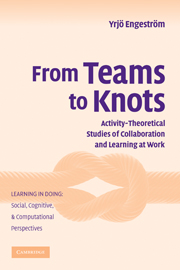Book contents
- Frontmatter
- Contents
- Series Foreword
- Preface
- 1 Teams and the Transformation of Work
- 2 Disturbance Management and Masking in a Television Production Team
- 3 Teamwork between Adversaries: Coordination, Cooperation, and Communication in a Court Trial
- 4 Displacement and Innovation in Primary Care Medical Teams
- 5 Crossing Boundaries in Teacher Teams
- 6 Knowledge Creation in Industrial Work Teams
- 7 Teams, Infrastructures, and Social Capital
- 8 From Iron Cages to Webs on the Wind
- 9 Knotworking and Agency in Fluid Organizational Fields
- References
- Author Index
- Subject Index
- Titles in the series
6 - Knowledge Creation in Industrial Work Teams
Published online by Cambridge University Press: 05 June 2012
- Frontmatter
- Contents
- Series Foreword
- Preface
- 1 Teams and the Transformation of Work
- 2 Disturbance Management and Masking in a Television Production Team
- 3 Teamwork between Adversaries: Coordination, Cooperation, and Communication in a Court Trial
- 4 Displacement and Innovation in Primary Care Medical Teams
- 5 Crossing Boundaries in Teacher Teams
- 6 Knowledge Creation in Industrial Work Teams
- 7 Teams, Infrastructures, and Social Capital
- 8 From Iron Cages to Webs on the Wind
- 9 Knotworking and Agency in Fluid Organizational Fields
- References
- Author Index
- Subject Index
- Titles in the series
Summary
Putting Knowledge Creation Under a Magnifying Glass
In Chapter 3, I asked how innovation possibilities emerge in a team. I identified expansive transitions, moves from coordination to cooperation and communication in the way a team interacts and relates to its object. These concepts, further elaborated in Chapter 4, led to the tension between fixation and flow, or stabilization and destabilization, in a team's activity. In Chapter 5, yet another mechanism, namely, boundary crossing, was identified. All these findings may be regarded as elements or prerequisites that facilitate innovative learning and knowledge creation in work teams. But the process of knowledge creation itself remains to be explored in detail. So in this chapter I ask: How do teams learn and create new knowledge?
I define innovative organizational learning as collaborative learning in work organizations that produces new solutions, procedures, or systemic transformations in organizational practices (Engeström, 1995a). Studies of innovative organizational learning have thus far mostly produced relatively general conceptual tools (e.g., Argyris & Schön, 1978; Senge, 1990). Although it is commonly acknowledged that innovative learning at work has a complex cyclic character (e.g., Dixon, 1994), there have been few detailed attempts at theorizing such cycles and modeling their steps.
One of the most interesting attempts is the book by Nonaka and Takeuchi (1995). These authors focus exclusively on innovative learning, which they prefer to call knowledge creation in organizations. Nonaka and Takeuchi propose a theory of knowledge upon which they build a model of cycles of knowledge production.
- Type
- Chapter
- Information
- From Teams to KnotsActivity-Theoretical Studies of Collaboration and Learning at Work, pp. 118 - 168Publisher: Cambridge University PressPrint publication year: 2008

